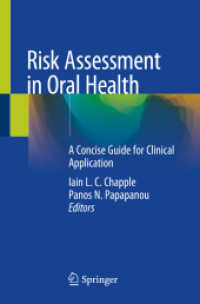- ホーム
- > 洋書
- > 英文書
- > Science / Mathematics
基本説明
With a stronger focus on hypothesis testing, elaborate practical sections and recent versions of sequence analysis and software, this edition includes six new chapters. Topics on Bayesian inference, tree topology testing and the impact of recombination on phylogenies have been added as well as a detailed section on molecular adaptation.
Full Description
The Phylogenetic Handbook is a broad, hands on guide to theory and practice of nucleotide and protein phylogenetic analysis. This second edition includes six new chapters, covering topics such as Bayesian inference, tree topology testing and the impact of recombination on phylogenies, as well as a detailed section on molecular adaptation. The book has a stronger focus on hypothesis testing than the previous edition, with more extensive discussions on recombination analysis, detecting molecular adaptation and genealogy-based population genetics. Many chapters include elaborate practical sections, which have been updated to introduce the reader to the most recent versions of sequence analysis and phylogeny software, including BLAST, FastA, Clustal, T-coffee, Muscle, DAMBE, Tree-puzzle, Phylip, MEGA, PAUP*, IQPNNI, CONSEL, ModelTest, Prottest, PAML, HYPHY, MrBayes, BEAST, LAMARC, SplitsTree, and RDP. Many analysis tools are described by their original authors, resulting in clear explanations that constitute an ideal teaching guide for advanced-level undergraduate and graduate students.
Contents
Part I. Introduction: 1. Basic concepts of molecular evolution Anne-Mieke Vandamme; Part II. Data Preparation: 2. Sequence databases and database searching Guy Bottu, Marc Van Ranst and Philippe Lemey; 3. Multiple sequence alignment Des Higgins and Philippe Lemey; Part III. Phylogenetic Inference: 4. Nucleotide substitution models Korbinian Strimmer, Arndt von Haeseler and Marco Salemi; 5. Phylogenetic inference based on distance methods Yves Van de Peer and Marco Salemi; 6. Phylogenetic inference using maximum likelihood methods Heiko A. Schmidt and Arndt von Haeseler; 7. Bayesian phylogenetic analysis using MRBAYES Fredrik Ronquist, Paul van der Mark and John P. Huelsenbeck; 8. Phylogeny inference based on parsimony and other methods using PAUP* David L. Swofford and Jack Sullivan; 9. Phylogenetic analysis using protein sequences Fred R. Opperdoes and Philippe Lemey; Part IV. Testing Models and Trees: 10. Selecting models of evolution David Posada; 11. Molecular clock analysis Philippe Lemey and David Posada; 12. Testing tree topologies Heiko Schmidt; Part V. Molecular Adaptation: 13. Natural selection and adaptation of molecular sequences Oliver G. Pybus and Beth Shapiro; 14. Estimating selection pressures on alignments of coding sequences Sergei L. Kosakovsky Pond, Art F. Y. Poon, and Simon D. W. Frost; Part VI. Recombination: 15. Introduction to recombination detection Philippe Lemey and David Posada; 16. Detecting and characterizing individual recombination events Mika Salminen and Darren Martin; Part VII. Population Genetics: 17. The coalescent: population genetic inference using genealogies Allen Rodrigo; 18. Bayesian evolutionary analysis by sampling trees Alexei Drummond and Andrew Rambaut; 19. LAMARC: estimating population genetic parameters from molecular data Mary K. Kuhner; Part VIII. Additional Topics: 20. Assessing substitution saturation with DAMBE Xuhua Xia and Philippe Lemey; 21. Split networks: a tool for exploring complex evolutionary relationships in molecular data Vincent Moulton and Katharina T. Huber.








